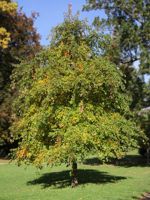Mon-Fri 9am - 5pm Mountain time
Common Hackberry vs Black Gum
Nyssa sylvatica
Celtis occidentalis
NOT AVAILABLE THIS SEASON - MIGHT RETURN
Black Gum is a slow-growing ornamental shade tree with a dense pyramidal shape. The foliage is dark green in the summer, and transitions to bright fall colours which include red, orange, purple, and gold. It is commonly used as an ornamental tree in parks and large gardens as a specimen or shade tree.
The small greenish white flowers provide nectar for bees and black tupelo honey is a sought after flavour. The small dark blue fruits which ripen in late summer will attract birds and other animals to your yard. The fruits are edible, but very sour, and are primarily used for pies, flavouring, and drinks. Plant the Black Gum where it will live long-term, as it has a large taproot and does not transplant well.
The Common Hackberry is a medium-sized deciduous tree that resembles the American Elm but is immune to Dutch Elm Disease. They are versatile and can adapt to a variety of growing conditions.
It produces purple-red, berry-like fruit with a large seed in the center. Both the sweet flesh, which tastes similar to dates, and the crunchy seed are edible. The fruit remains on the tree throughout the winter, offering a valuable food source for birds and other wildlife.
The Common Hackberry can also be a great addition to a pollinator garden. The tree itself is a host for the larvae of several butterfly species and the flowers provide a source of pollen and nectar.

